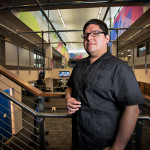![Horse500[1]](http://www.noticiasdenaccs.org/wp-content/uploads/2016/03/Horse5001-228x300.jpg) by Dr. Eric Castillo
by Dr. Eric Castillo
Luis Jiménez was a titan in the art world; his monumental sculptures and poignant lithographs reveal his commitment for a shared humanity as well as provide a platform for his social and artistic agendas. Jiménez’s art combined European artistic practices and Chicana/o vernacular aesthetics. His innovative use of fiberglass materials and archetypal themes position his unique perspective within formalized discussions in art history. His ability to cross over into the American art scene enabled him to cross borders historically closed off to artists of color.
Jiménez’s art critically examined regional and national politics and offered an understanding about American art that is hybrid, differential, and contingent, rather than pure or monolithic. Differentiated by his style politics and motivated by his sociocultural interventions, Jiménez authored unique methods that engaged with contemporary time.
In 1991, Jiménez was offered a commission by the Denver International Airport to complete a sculpture that would reflect the life and experiences of the Southwest. Initially designed for Terminal C inside of the airport, Jiménez proposed a large-scale version of a mustang; he felt the sculpture would pay tribute to this country’s historic relationship with the horse:
What I’ve proposed for Denver is a mustang scenic overlook. I am also proposing a series of plaques tracing the history of the American mustang from the original reintroduction of the horse by the Spaniards, to the Indian pony that they developed from the mustang, then the American cow pony and quarter horse that was developed from mustangs (1994 160).
Designed to frame downtown Denver, Pike’s Peak, and the mountains, Mesteño would have signified a magnificent accomplishment for Jiménez. Completing a monumental piece at a public venue meant he would leave his mark in the art world.
As the largest public artwork of his career, the 32-foot bucking bronco titled Mesteño was designed to be free standing on its hind two legs. Mesteño’s electric blue color, fiery red light bulb eyes, and black veins would course its body, towering over the mile-high landscape while framing the electric sunset and the Colorado Rockies.
In a 1999 interview for ARTLIES magazine, Jiménez informed interviewer Susie Kalil the prospects of such a tremendous commission, stating he was experiencing burnout from the DIA project. “We all have burnout…” Jiménez stated; “And I have burnout, especially on these large pieces. I have a piece that I haven’t delivered for Denver. I keep asking myself why it’s taking so long to do it” (56). Jiménez’s older age and blindness in his left eye were of primary concern: “I’m not as strong as I used to be! And I don’t have the energy to go three days in a row without sleep like I used to!” (ibid).
On June 13th, 2006 Jiménez passed away in the midst of completing the Mesteño. Pressed for time, Jiménez attempted to complete the torso but the massive piece had little structural support without the crane. In one swift movement, the sculpture fell off the metal structure, crushing Jiménez against the reinforcement bar. Writhing in agony, he called out for help; the two assistants rushed to him, pushing the fiberglass sculpture aside. Jiménez was rushed off to Lincoln County Medical Center where he was later pronounced dead (Rancho las Voces 2006). News of his death spread quickly as his family, friends, and art community mourned the loss of one of the most significant American artists of our time. Memorial services across the country honored Jiménez, celebrating the success of a passion artist whose vision enlightened and transformed the visual iconography of U.S. culture.
On February 11, 2008 Mesteño was installed along Peña Boulevard in a private ceremony where art collectors, journalists, politicians, and Jiménez’s family gathered to celebrate the monument. Portrayed by many as Luis Jiménez’s crowing achievement, Mesteño signified a large-scale intervention in the field of Western art. But artist Luis Jiménez’s true crowning achievement was not in one single piece of art, but in the cadre of art he created that helped redefine American art and identity.
Unwelcomed and unappreciated by many Denver residents and art critics for its “apocalyptic, devilish” look and its extremely high price tag, Mesteño was also praised and celebrated by communities across Denver and the Southwest for its revisionism. Luis Jiménez saw something much greater than just a blue mustang when he created the sculpture; this monument memorialized an important actor in creating the U.S. West.
A Chicano artist who successfully crossed over into the American art world, Luis Jiménez profoundly influenced the Pop art scene, Chicana/o art, U.S. sculpture, and Western iconography. Raised in a life that was surrounded by borders–geographical, cultural, political, and social–he was able to produce images that transcended these borders and showed the intercultural, transnational history of his life and the United States. Unafraid of the consequences of transgressing these borders, Luis Jiménez made it acceptable for people to understand American identity as something hybrid and ever changing.
 Dr. Eric Castillo is the Assistant Dean and Campus Director for the School of Professional and Continuing Studies at Springfield College in Houston, Tejas. As a social justice educator and administrator, Dr. Castillo works on narrowing the achievement gap between historically disenfranchised populations and higher education.
Dr. Eric Castillo is the Assistant Dean and Campus Director for the School of Professional and Continuing Studies at Springfield College in Houston, Tejas. As a social justice educator and administrator, Dr. Castillo works on narrowing the achievement gap between historically disenfranchised populations and higher education.
